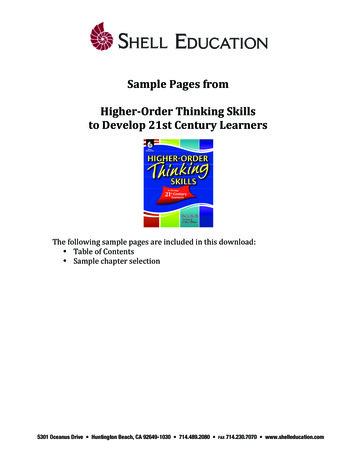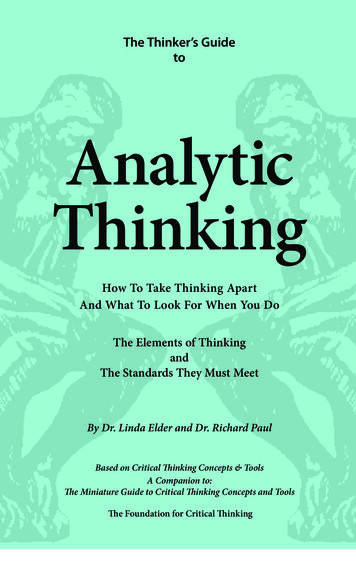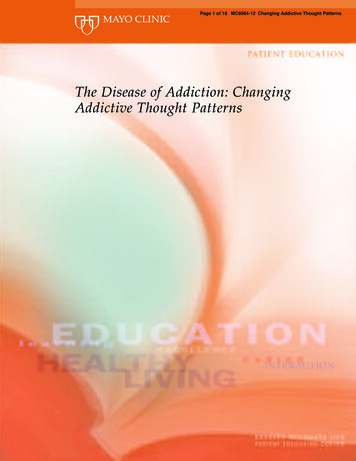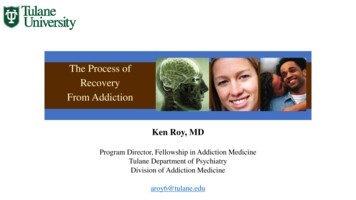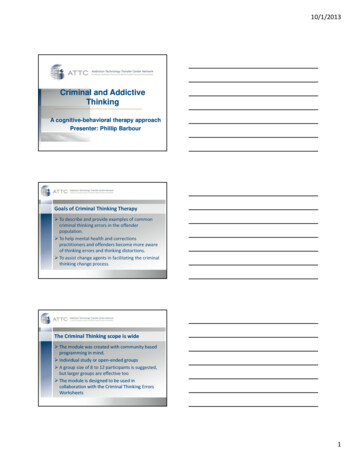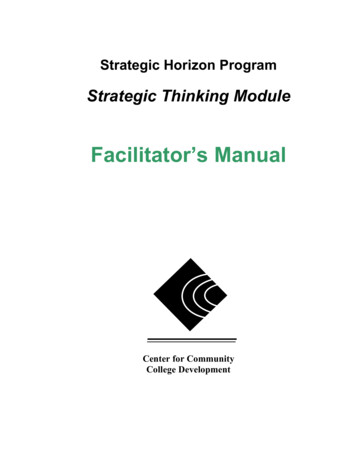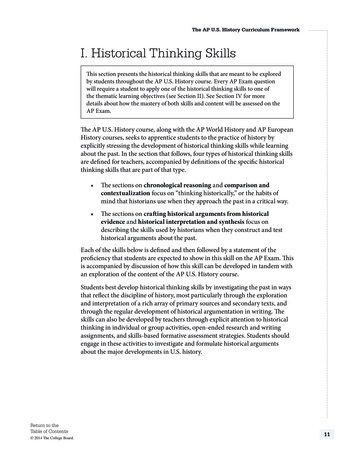
Transcription
The AP U.S. History Curriculum FrameworkI. Historical Thinking SkillsThis section presents the historical thinking skills that are meant to be exploredby students throughout the AP U.S. History course. Every AP Exam questionwill require a student to apply one of the historical thinking skills to one ofthe thematic learning objectives (see Section II). See Section IV for moredetails about how the mastery of both skills and content will be assessed on theAP Exam.The AP U.S. History course, along with the AP World History and AP EuropeanHistory courses, seeks to apprentice students to the practice of history byexplicitly stressing the development of historical thinking skills while learningabout the past. In the section that follows, four types of historical thinking skillsare defined for teachers, accompanied by definitions of the specific historicalthinking skills that are part of that type.t The sections on chronological reasoning and comparison andcontextualization focus on “thinking historically,” or the habits ofmind that historians use when they approach the past in a critical way.t The sections on crafting historical arguments from historicalevidence and historical interpretation and synthesis focus ondescribing the skills used by historians when they construct and testhistorical arguments about the past.Each of the skills below is defined and then followed by a statement of theproficiency that students are expected to show in this skill on the AP Exam. Thisis accompanied by discussion of how this skill can be developed in tandem withan exploration of the content of the AP U.S. History course.Students best develop historical thinking skills by investigating the past in waysthat reflect the discipline of history, most particularly through the explorationand interpretation of a rich array of primary sources and secondary texts, andthrough the regular development of historical argumentation in writing. Theskills can also be developed by teachers through explicit attention to historicalthinking in individual or group activities, open-ended research and writingassignments, and skills-based formative assessment strategies. Students shouldengage in these activities to investigate and formulate historical argumentsabout the major developments in U.S. history.Return to theTable of Contents 2014 The College Board.11
The AP U.S. History Curriculum FrameworkSkill TypeHistorical Thinking SkillI. Chronological Reasoning1. Historical Causation2. Patterns of Continuity and Change over Time3. PeriodizationII. Comparison and Contextualization4. Comparison5. ContextualizationIII. Crafting Historical Arguments fromHistorical Evidence6. Historical ArgumentationIV. Historical Interpretation andSynthesis8. Interpretation7. Appropriate Use of Relevant Historical Evidence9. SynthesisSkill Type I: Chronological ReasoningSkill 1: Historical CausationHistorical thinking involves the ability to identify, analyze, and evaluate therelationships among multiple historical causes and effects, distinguishingbetween those that are long-term and proximate, and among coincidence,causation, and correlation.Proficient students should be able to t Compare causes and/or effects, including between short- and long-termeffects.t Analyze and evaluate the interaction of multiple causes and/or effects.t Assess historical contingency by distinguishing among coincidence, causation,and correlation, as well as critiquing existing interpretations of cause andeffect.How could this skill be approached in the AP U.S. History course?This skill asks students to identify and compare basic causes and/or effects andto distinguish between both short- and long-term causes and effects. Over thespan of the course, students should move from describing causes to analyzingand evaluating the interaction of multiple causes and/or effects.In U.S. history, arguments about causation are similar to those in other histories orsubdisciplines. For example, an effective analysis of the significance of the Civil Warmight consider both long-term and proximate causes as well as short- and longterm effects. So, discussing the long-term impact of growing economic divergencebetween the North and South could be weighed against the relatively short-termCongressional gridlock leading up to the outbreak of hostilities. Citing multiplecontributing causes may also provide students with more compelling evidence tosupport larger investigations than focusing on a single cause. For example, teacherscan explore the roots of the modern environmental movement in the Progressive12Return to theTable of Contents 2014 The College Board.
The AP U.S. History Curriculum FrameworkEra and the New Deal, as well as debate underlying and proximate causes ofenvironmental catastrophes arising from pesticide use and offshore oil drilling.Skill 2: Patterns of Continuity and Change over TimeHistorical thinking involves the ability to recognize, analyze, and evaluatethe dynamics of historical continuity and change over periods of time ofvarying lengths, as well as the ability to relate these patterns to larger historicalprocesses or themes.Proficient students should be able to t Analyze and evaluate historical patterns of continuity and change over time.t Connect patterns of continuity and change over time to larger historicalprocesses or themes.How could this skill be approached in the AP U.S. History course?This skill asks students to recognize, describe, and analyze instances ofhistorical patterns of continuity and change over time. Although worldhistorians frequently have to look for very large patterns of continuity andchange across centuries, U.S. history researchers can focus on individuals anda somewhat narrower scope of time. Although this difference in scale cansometimes lead to an overemphasis on details rather than a description of largerpatterns, it underscores the importance of integrating content with coursethemes. For example, the course theme and concept of identity can be discussedas both the denial and extension of political and economic rights to specificgroups over different periods of time while simultaneously highlighting theheroic accomplishments of individuals during their struggle for recognition.A teacher might choose to examine the restrictions of rights during America’swars in contrast to the opportunities for minorities to show their patriotism byserving in the armed forces, such as the internment of Japanese Americans andthe heroism of Daniel Inouye in World War II.Skill 3: PeriodizationHistorical thinking involves the ability to describe, analyze, evaluate, andconstruct models that historians use to organize history into discrete periods.To accomplish this periodization of history, historians identify turning pointsand recognize that the choice of specific dates gives a higher value to onenarrative, region, or group than to other narratives, regions, or groups. Howa historian defines historical periods depends on what the historian considersmost significant — political, economic, social, cultural, or environmentalfactors. Changing periodization can change a historical narrative. Moreover,historical thinking involves being aware of how the circumstances and contextsof a historian’s work might shape his or her choices about periodization.Return to theTable of Contents 2014 The College Board.13
The AP U.S. History Curriculum FrameworkProficient students should be able to t Explain ways that historical events and processes can be organized withinblocks of time.t Analyze and evaluate competing models of periodization of U.S. history.How could this skill be approached in the AP U.S. History course?Students should be familiar with different ways that historians divide time intohistorical periods and identify turning points in the past. Students might beginto develop this skill by examining and evaluating the model of periodizationprovided in this framework. Students might then compare this periodizationagainst competing models, such as the one used in their textbook.Periodization has become increasingly relevant to U.S. history because recenthistorical researchers have challenged traditional ways of categorizing the past,particularly in relation to such underrepresented groups as American Indians.The result is that different texts and syllabi may use different periodizations forunit titles. This is an opportunity for teachers to challenge students to reflecton how the choice of different beginning and ending dates and the labels forspecific “time periods” (such as the Progressive Era) can alter the historicalnarrative and give a higher value to one group over another.For example, the dates one sets for the beginning of the “new conservative”movement in the United States can emphasize one political and social narrativeover another, impacting one’s interpretation of the extent of social and political“reforms.” Teachers can pose questions such as: What is the best way ofdividing the history of the United States into meaningful periods? What are theconsequences of choosing one set of dates for a particular movement instead ofanother time frame? Application of this skill can promote healthy discussionsand deeper analyses of historical evidence.Skill Type II: Comparison and ContextualizationSkill 4: ComparisonHistorical thinking involves the ability to describe, compare, and evaluatemultiple historical developments within one society, one or more developmentsacross or between different societies, and in various chronological andgeographical contexts. It also involves the ability to identify, compare, andevaluate multiple perspectives on a given historical experience.Proficient students should be able to t Compare related historical developments and processes across place, time,and/or different societies or within one society.t Explain and evaluate multiple and differing perspectives on a given historicalphenomenon.14Return to theTable of Contents 2014 The College Board.
The AP U.S. History Curriculum FrameworkHow could this skill be approached in the AP U.S. History course?This skill asks students to compare related historical developments andprocesses across place, time, or different societies (or within one society). Moresophisticated students might be able to compare related historical developmentsand processes across more than one variable, such as geography, chronology,and different societies (or within one society), recognizing multiple anddiffering perspectives on a given historical phenomenon.In contrast to the research conducted in other histories, U.S. history researcherscan focus on specific phenomena among fewer cultures over just a few centuries.One of the central questions of world history might be: How similar and howdifferent were historical changes in different parts of the world? A similarcomparison question in U.S. history might be: How similar and how differentwere the periods of U.S. expansion, or how does “conservatism” compare inthe 1920s, 1950s, and 1980s? Another means of teaching this skill is to askstudents to compare thematic developments in different time periods, such ashow environmental attitudes and policies in the first decade of the 20th centurycompare with those in the last decade of that century, or the comparative impactof migrations to the United States in the 1890s and the 1980s.Skill 5: ContextualizationHistorical thinking involves the ability to connect historical events andprocesses to specific circumstances of time and place and to broader regional,national, or global processes.Proficient students should be able to t Explain and evaluate ways in which specific historical phenomena, events, orprocesses connect to broader regional, national, or global processes occurringat the same time.t Explain and evaluate ways in which a phenomenon, event, or processconnects to other, similar historical phenomena across time and place.How could this skill be approached in the AP U.S. History course?This skill asks students to recognize and explain ways in which historicalphenomena or processes connect to broader regional, national, or globalprocesses. The “context” for world history is the world as a whole; for Europeanhistory, it is Europe as a whole; and for U.S. history, it is primarily the UnitedStates itself. The skill of contextualization therefore takes on different formsdepending on the scope of time and geography. One of the central questionsof world history is: How does the history of this specific region or era fitinto the larger story of world history as a whole? For U.S. history, that samecontextualization question might be: How does the history of a particulargroup, region, or era fit into the larger story of the development of the UnitedStates? However, there are a growing number of topics in which teachersReturn to theTable of Contents 2014 The College Board.15
The AP U.S. History Curriculum Frameworkshould consider challenging students with the broader context, especially whenconsidering the theme of America in the world. For example, U.S. territorialexpansion, emancipation, the Great Depression, and, of course, foreign policyinitiatives are increasingly bringing into play the perspectives of other nationsand world regions. One could also explore the interaction between a watershedevent like Reconstruction and the civil rights movement.Skill Type III: Crafting Historical Arguments fromHistorical EvidenceSkill 6: Historical ArgumentationHistorical thinking involves the ability to define and frame a question aboutthe past and to address that question through the construction of an argument.A plausible and persuasive argument requires a clear, comprehensive, andanalytical thesis, supported by relevant historical evidence — not simplyevidence that supports a preferred or preconceived position. In addition,argumentation involves the capacity to describe, analyze, and evaluate thearguments of others in light of available evidence.Proficient students should be able to t Analyze commonly accepted historical arguments and explain how anargument has been constructed from historical evidence.t Construct convincing interpretations through analysis of disparate, relevanthistorical evidence.t Evaluate and synthesize conflicting historical evidence to construct persuasivehistorical arguments.How could this skill be approached in the AP U.S. History course?This skill asks students to be able to describe commonly accepted historicalarguments about the nature of the past and then explain how such argumentshave been constructed from historical evidence. Over the span of the course,students should move from describing to evaluating the conflicting historicalevidence used in making plausible historical arguments. In U.S. history, theskill of historical argumentation often operates in conjunction with coursethemes that transcend several periods and with other skills. For example, inconjunction with the theme of politics and power, students might be askedto examine evidence and construct an argument about the causes of the CivilWar. The application of argumentation and causation might take students backto previous centuries to construct a coherent thesis with supporting evidencethat includes a sophisticated analysis of the introduction of slavery to NorthAmerican colonies, relative growth and economic divergence of geographicregions, the impact of migration and technology, Congressional gridlock, andpolitical ideas about democracy and federalism.16Return to theTable of Contents 2014 The College Board.
The AP U.S. History Curriculum FrameworkSkill 7: Appropriate Use of Relevant Historical EvidenceHistorical thinking involves the ability to describe and evaluate evidence aboutthe past from diverse sources (including written documents, works of art,archaeological artifacts, oral traditions, and other primary sources) and requiresstudents to pay attention to the content, authorship, purpose, format, andaudience of such sources. It involves the capacity to extract useful information,make supportable inferences, and draw appropriate conclusions from historicalevidence while also noting the context in which the evidence was produced andused, recognizing its limitations, and assessing the points of view it reflects.Proficient students should be able to t Analyze features of historical evidence such as audience, purpose, point ofview, format, argument, limitations, and context germane to the evidenceconsidered.t Based on analysis and evaluation of historical evidence, make supportableinferences and draw appropriate conclusions.How could this skill be approached in the AP U.S. History course?This skill asks students to analyze documents for one or more of the followingfeatures: audience, purpose, point of view, format, argument, limitations, andcontext germane to the historical evidence considered. Based on their analysisof historical evidence, students should then be able to make supportableinferences or draw appropriate conclusions. AP teachers can expose studentsto a variety of sources to help them draw their own conclusions and inferences.Recent research in U.S. history highlights the inclusion of underrepresentedgroups and cultures, which also has increased the diversity of sources thathistorians use. For example, in determining the relationship of NativeAmerican tribes to their environment and making assertions about why somepersevered and others disappeared, students may have to rely on archaeologicalor geographical analysis instead of the more traditional forms of evidencein historical research. In addition, popular culture provides useful sourcesfor examining decades such as the 1950s; when exploring the course themeof America in the world, students may have to examine evidence beyondAmerican actors and actions.Skill Type IV: Historical Interpretation and SynthesisSkill 8: InterpretationHistorical thinking involves the ability to describe, analyze, evaluate, andconstruct diverse interpretations of the past, and being aware of how particularcircumstances and contexts in which individual historians work and write alsoshape their interpretation of past events. Historical interpretation requiresanalyzing evidence, reasoning, determining the context, and evaluating pointsof view found in both primary and secondary sources.Return to theTable of Contents 2014 The College Board.17
The AP U.S. History Curriculum FrameworkProficient students should be able to t Analyze diverse historical interpretations.t Evaluate how historians’ perspectives influence their interpretations and howmodels of historical interpretation change over time.How could this skill be approached in the AP U.S. History course?This skill asks students to both describe and evaluate diverse historicalinterpretations. To help students create their own interpretation of U.S. history,students and teachers should examine changing historical interpretationsover time, such as the different ways that historians have interpreted theinstitution of American slavery or evaluated Reconstruction. Historianshave the added challenge of addressing “presentism,” or how contemporaryideas and perspectives are anachronistically introduced into depictionsand interpretations of historical events. The skill of interpretation becomesparticularly important as students progress from describing what they arelearning about past events to reflecting on assorted historical evidence in termsof contextual values and cultural bias.Skill 9: SynthesisHistorical thinking involves the ability to develop meaningful and persuasivenew understandings of the past by applying all of the other historical thinkingskills, by drawing appropriately on ideas and methods from different fieldsof inquiry or disciplines, and by creatively fusing disparate, relevant, andsometimes contradictory evidence from primary sources and secondary works.Additionally, synthesis may involve applying insights about the past to otherhistorical contexts or circumstances, including the present.Proficient students should be able to t Combine disparate, sometimes contradictory evidence from primary sourcesand secondary works in order to create a persuasive understanding of the past.t Apply insights about the past to other historical contexts or circumstances,including the present.18Return to theTable of Contents 2014 The College Board.
The AP U.S. History Curriculum FrameworkHow could this skill be approached in the AP U.S. History course?This skill asks students to demonstrate an understanding of the past bymaking an argument that draws appropriately on ideas from different fieldsof inquiry or disciplines when presented to them in the form of data and/orarguments. Synthesis takes distinctive forms depending on the subdisciplineor history course because each grapples with such diverse materials. Unlikethe other histories, in U.S. history there is a predisposition of developing asingle narrative that consolidates and merges many different cultures. Yet, thedevelopment of such a narrative raises the historiographical question aboutwhich groups are included or excluded from the story. Increasingly, historiansare pulling evidence from a variety of disciplines and using a variety of otherskills in the creation of new conceptions about past events. Students should beencouraged to challenge the narratives to which they are exposed so that theywill have a better understanding of their place in an increasingly globalized anddiverse world.Return to theTable of Contents 2014 The College Board.19
The AP U.S. History Curriculum FrameworkII. Thematic Learning ObjectivesThe content learning objectives for the AP U.S. History course and exam areorganized under seven themes, which are topics of historical inquiry to explorethroughout the AP U.S. History course.t Identityt Work, exchange, and technologyt Peoplingt Politics and powert America in the worldt Environment and geography — physical and humant Ideas, beliefs, and cultureThese themes focus student understanding of major historical issues anddevelopments, helping students to recognize broad trends and processes thathave emerged over centuries in what has become the United States. The pagesthat follow describe each theme in detail, along with two or three overarchingquestions that can be used to guide student inquiry during the entire course.The phrasing of each learning objective presents a particular kind of historicalrelationship or development; for example, when the learning objective statesthat students can explain how and why certain factors affected a particularphenomenon, it implies that students should reason about this event usingthinking skills such as causation and continuity/change over time.The tables for the thematic learning objectives also indicate where requiredcourse content related to the learning objective can be found in the conceptoutline. This approach ensures that teachers can continue to teach the coursechronologically while still highlighting the relationship between specifichistorical developments and larger, thematic understandings. Teachers mayalso investigate U.S. history with their students using themes or approaches oftheir own choosing, keeping in mind that all questions on the AP U.S. HistoryExam will measure student understanding of the specified thematic learningobjectives.20Return to theTable of Contents 2014 The College Board.
AP Exam.!e AP U.S. History course, along with the AP World History and AP European History courses, seeks to apprentice students to the practice of history by explicitly stressing the development of historical thinking skills while learning about the past. In the section that follows,


